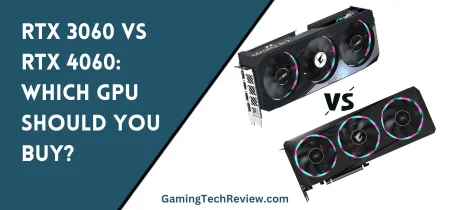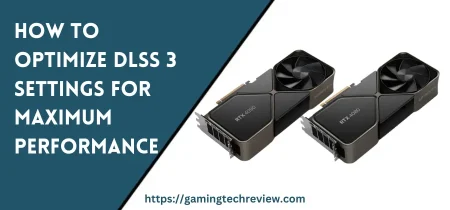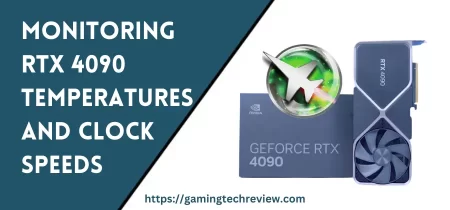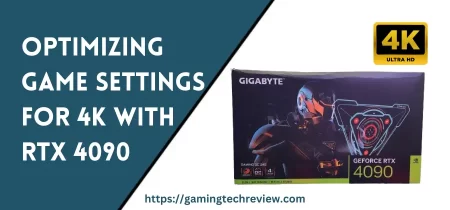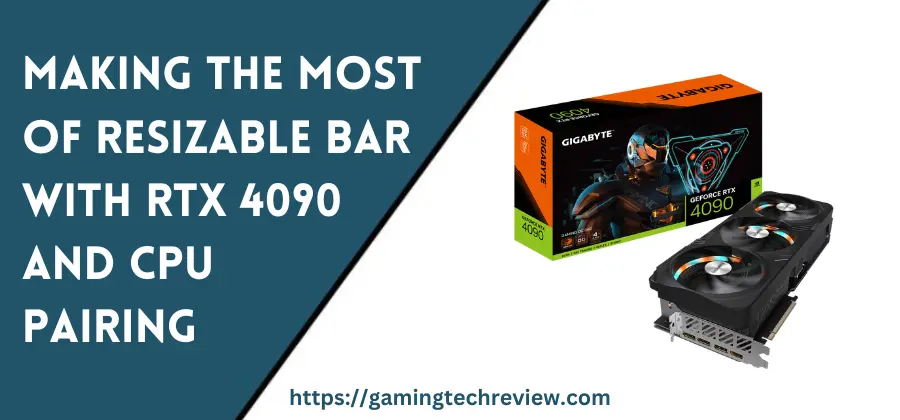
NVIDIA’s flagship GeForce RTX 4090 graphics card offers immense gaming performance, but enabling PCIe Resizable BAR support allows it to reach even higher frame rates. By optimizing Resizable BAR and pairing the RTX 4090 with a suitable high-end CPU, you can build an incredible gaming PC to fully experience titles in 4K and beyond.
Follow this comprehensive guide to unlock the true power of the RTX 4090’s 24GB of GDDR6X VRAM and experience buttery smooth high resolution gaming. Let’s dive in!
What is Resizable BAR and How Does It Improve Performance?
Resizable Base Address Register (BAR) is an advanced PCI Express interface technology supported by modern GPUs, CPUs and motherboard chipsets. Here’s a technical overview of how it works:
- Traditionally, CPUs can only access a GPU’s frame buffer using 256MB chunks due to legacy hardware limitations. This forces constant data requests and resending, adding latency.
- Resizable BAR enables the CPU to access the entire GPU frame buffer directly as one large contiguous chunk of memory, improving efficiency.
- Full frame buffer access reduces the back and forth requests between CPU and GPU. Streamlined access results in significant latency reduction.
- By eliminating steps and latency, overall communication between the CPU and GPU becomes much more efficient. This efficiency translates directly into higher average and 99th percentile FPS.
- Overall immersion and smoothness is improved thanks to the CPU being able to pull full frame data faster for processing.
The amount of performance benefit varies based on the game engine, resolution, effects load and other factors. But when optimized properly, Resizable BAR can provide a nice FPS boost in many titles, making it worth enabling.
Hardware and Software Requirements
To take advantage of Resizable BAR’s performance benefits yourself, your system will need to meet the following hardware and software requirements:
- GPU – NVIDIA GeForce RTX 30 series or newer GPU, or AMD Radeon RX 6000 series or newer. RTX 4090 fully supported.
- CPU – AMD Ryzen 3000 series or newer, or Intel 10th Gen Core series or newer. High core count recommended.
- Motherboard – Must support Resizable BAR in BIOS and have PCIe 3.0 or 4.0 slot for the GPU. Z590, X570 and B550 or newer chipsets recommended.
- OS – Windows 10 version 2004 or newer, or latest version of Windows 11. Older Windows builds do not support Resizable BAR.
- UEFI BIOS – Your motherboard must have an up-to-date UEFI BIOS installed that enables the Resizable BAR option for your CPU and GPU combination. Critical for full support.
Meeting these hardware and software requirements ensures maximum compatibility and stability when enabling Resizable BAR. Having PCIe 4.0 or higher capabilities also allows your GPU to take full advantage of the bandwidth.
Step-by-Step Guide to Enabling Resizable BAR
Once you’ve verified your system meets the requirements, follow these steps to enable Resizable BAR properly:
- Update motherboard BIOS to the latest version from manufacturer’s website. Follow instructions to flash BIOS safely.
- Reboot into BIOS settings, locate Resizable BAR option. May be labeled differently on some motherboards. Enable setting.
- Save changes and reboot.
- Download and install the latest GPU drivers from NVIDIA or AMD depending on your graphics card.
- Enable Resizable BAR in the NVIDIA Control Panel or AMD Radeon Software. Requires system reboot.
- Restart one more time for changes to fully complete. Resizable BAR now active!
- Run gaming benchmarks with BAR on vs off to quantify performance uplift.
- Keep GPU drivers updated for best compatibility and performance. May need to toggle BAR back on after major driver updates.
Following these steps carefully will ensure Resizable BAR is operational. Be sure to enable any above 4G memory options in BIOS as well. With everything configured properly, you’re ready to start enjoying the benefits!
Ideal CPU Pairings for RTX 4090 and Resizable BAR
To fully capitalize on Resizable BAR’s lower latency and extract maximum frame rates from your RTX 4090, you’ll want to pair it with a suitable high-end CPU based on Intel Alder Lake, Raptor Lake or AMD Zen 4:
- Intel Core i9-13900K – Intel’s newest Raptor Lake flagship offers 24 cores and 32 threads with high clock speeds up to 5.8 GHz. Ideal for eliminating CPU bottlenecks when gaming with Resizable BAR enabled.
- AMD Ryzen 9 7950X – AMD’s latest Zen 4 architecture flagship with 16 cores, 32 threads and boost up to 5.7 GHz is a powerful pairing for the 4090 to achieve super high frame rates thanks to precision boost overdrive and support for speedy DDR5 RAM.
- Intel Core i9-12900K – Alder Lake’s efficient hybrid architecture combines high performance and efficiency cores for great Resizable BAR gaming performance. More affordable option with similar gaming prowess to 13900K.
- AMD Ryzen 9 5900X/5950X – Previous gen Zen 3 chips with 12 or 16 cores still deliver excellent Resizable BAR gaming performance when paired with RTX 4090. Great options if upgrading from AM4 platform.
No matter if you choose AMD or Intel, a high core count CPU with strong single threaded and multi-threaded performance is ideal to avoid bottlenecking the 4090. This allows the CPU to quickly handle full frame buffer throughput from the GPU.
Motherboard Considerations for Resizable BAR Builds
The right motherboard is also crucial to enable the full performance benefits of Resizable BAR. Here are top options for Intel 13th Gen, Intel 12th Gen and AMD Ryzen configurations:
- Z790 motherboards – For Intel Core i9-13900K, the new Z790 chipset paired with latest BIOS provides full PCIe 5.0 support for GeForce RTX 4090 allowing maximum bandwidth for Resizable BAR.
- Z690 motherboards – Z690 boards also work well for 13th Gen Intel CPUs, offering plenty of PCIe 4.0 connectivity. Only consider Z690 if unable to utilize full PCIe 5.0 speeds.
- Z690 motherboards – For Intel’s 12th Gen Core i9-12900K, Z690 motherboards with upgraded BIOS enable full PCIe 4.0 x16 bandwidth required for the RTX 4090.
- X670E motherboards – For AMD Ryzen 7950X, the high-end X670E chipset ensures PCIe 5.0 support and smoothest Resizable BAR performance.
- X670 / B650E – Mid-range X670 and B650E options allow PCIe 4.0 connectivity for the RTX 4090 which is still plenty of bandwidth for great BAR results.
For any platform, prioritize boards with PCIe 4.0 or 5.0 x16 slots to prevent bottlenecking the 4090. This allows it to fully stretch its legs with Resizable BAR enabled.
Benchmarking for Quantified Performance Uplift
To understand exactly how much of a performance benefit you are getting from Resizable BAR in specific games, conducting benchmark testing is highly recommended. Follow these tips:
- Use reliable benchmarking utilities like UL’s 3DMark along with in-game benchmarks in titles you play frequently. This provides a mix of synthetic and real-world game testing.
- When benchmarking games, test demanding titles at resolutions you actually play at like 1440p, 4K or ultrawide resolutions. This showcases real-world Resizable BAR benefits.
- First run benchmarks with Resizable BAR completely disabled to get baseline scores. Then enable it and re-run the exact same benchmarks under the same conditions for an apples-to-apples comparison.
- Pay attention to average FPS, 1% lows, .1% lows, and overall smoothness/frame time consistency. Resizable BAR improves all of these markers.
- Run each test multiple times to account for normal variability in scores. Calculate the percentage uplift Resizable BAR provides versus baseline disabled numbers.
By quantifying the exact gaming performance improvement Resizable BAR offers with your specific hardware, you can better appreciate the impact it provides. Testing also validates everything is set up correctly.
Optimization Tips for Maximum Performance
Follow these optimization tips to ensure Resizable BAR is running as efficiently as possible:
- Close all unnecessary background software and processes before benchmarking and gaming to allow the GPU maximum PCIe bandwidth to stretch its legs.
- Set Windows power plan to High Performance when benchmarking and gaming. This prevents CPU downclocking which could become a bottleneck.
- In NVIDIA Control Panel, enable Prefer Maximum Performance for power management mode. This forces constant high GPU clocks and power limit.
- Set all GPU-intensive in-game graphical options to maximum preset to shift load to the GPU: resolution, anti-aliasing, anisotropic filtering, draw distance, etc. Reduces potential CPU bottlenecks.
- Monitor CPU and GPU temperatures when testing. Hot components can thermal throttle, reducing performance. Aim to keep both under 80C with good case airflow.
- Keep GeForce Game Ready Driver updated for best performance and compatibility. Toggle Resizable BAR back on after major driver updates.
Following these tips will provide the most optimal, stutter-free experience possible while leveraging Resizable BAR’s capabilities fully. Enjoy the free extra performance!
Additional Gaming and System Optimization Tips
To further enhance your overall experience, implement these additional gaming and system tuning tips:
- Overclock your GPU by increasing power limit and core clocks in MSI Afterburner or equivalent. Adds extra performance on top of Resizable BAR gains.
- Overclock your CPU for extra single threaded and multi-threaded performance. Even small 5-10% overclocks can help feed the GPU more quickly.
- Use dual channel DDR4 3200MHz or faster memory. Ryzen 7000 supports DDR5 which is ideal. Faster memory improves CPU performance and frame delivery.
- Game at reasonable graphics settings that don’t excessively bottleneck your hardware. Finding the balance between visuals and FPS for your system’s capabilities.
- Enable G-SYNC or FreeSync if your display supports it for super smooth variable refresh rate gaming. Reduces stutters and screen tearing.
- Set Windows to ultimate performance power plan and ensure gamer mode is enabled for direct hardware access and less background overhead.
Following these additional tips will ensure your full system is tuned for the best possible real-world gaming experience with Resizable BAR reducing latency between your powerful components.
Conclusion
When configured and optimized properly, Resizable BAR delivers tangible improvements in average FPS, frametimes, smoothness and overall immersion. Combined with NVIDIA’s flagship RTX 4090 GPU, a high core count CPU, fast system memory and the right supporting components, you can build an incredible enthusiasts rig to experience games with all the eye-candy cranked up. If building a new system, factor Resizable BAR capabilities into your component selection.
For existing PCs, evaluate if your hardware meets the requirements to benefit from enabling this advanced feature. Follow the steps outlined in this detailed guide and enjoy the next level high resolution gaming experience!






